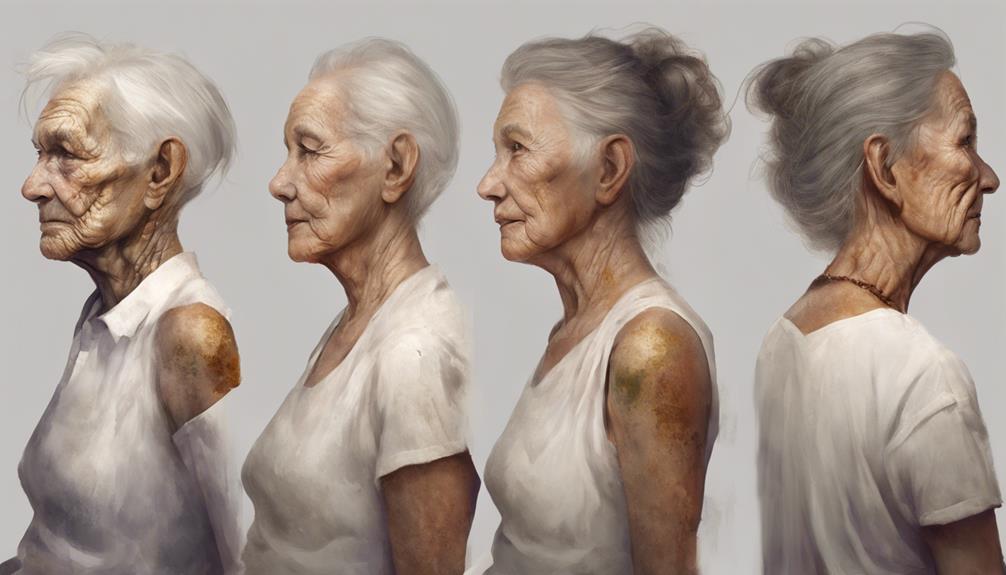As time progresses, the human body embarks on a journey of intricate transformations that shape our physical and mental well-being. The aging process is a symphony of biological adjustments, from the cardiovascular system to the skin's texture, each chapter unveiling a nuanced tale of adaptation and decline. Understanding the mechanisms behind these changes offers a glimpse into the complexities of aging and prompts reflection on the significance of proactive health management. Through this lens, we can explore how our bodies navigate the passage of time with resilience and vulnerability, inviting a deeper exploration into the mysteries of aging's effects.
Key Takeaways
- Cardiovascular system stiffens, increasing heart workload.
- Muscles weaken, bones become fragile with age.
- Digestive and urinary systems experience muscle decline.
- Cognitive function declines, varying based on genetics and lifestyle.
Cardiovascular Changes
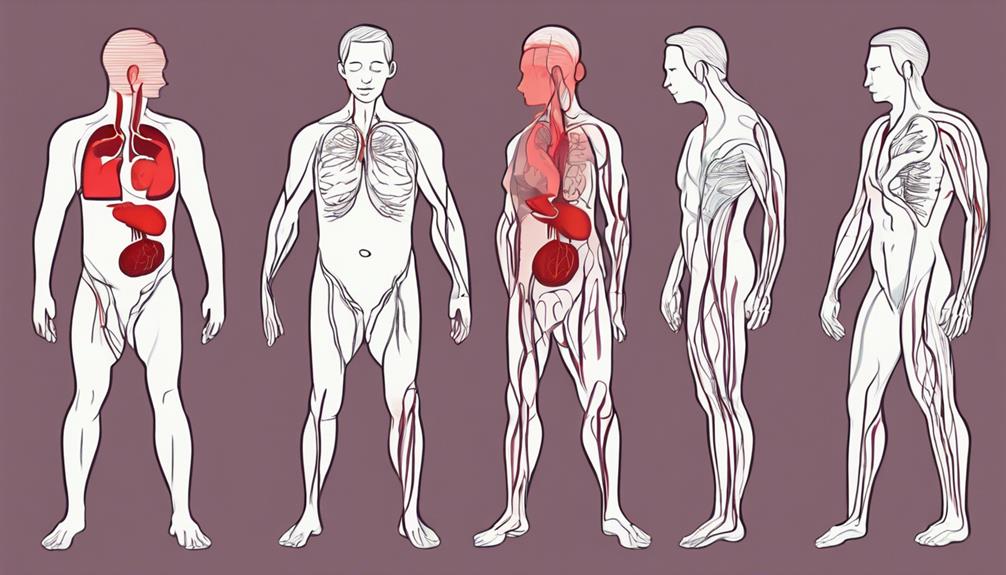
As individuals age, the cardiovascular system undergoes significant changes that can impact heart function and overall cardiovascular health. Stiffening of blood vessels and arteries is a common occurrence with aging, leading to increased workload on the heart. While resting heart rate typically remains stable, older individuals may experience limitations in the heart's ability to increase heart rate during physical activities. Age-related changes in the cardiovascular system also elevate the risks of high blood pressure and other cardiovascular issues. To mitigate these effects, incorporating regular physical activity and maintaining a healthy diet are crucial for supporting heart health and overall cardiovascular function in older adults. Additionally, effective stress management, sufficient sleep, and avoiding smoking play essential roles in preserving cardiovascular health as individuals age. By prioritizing these lifestyle factors, individuals can help maintain the integrity and functionality of their cardiovascular system as they grow older.
Musculoskeletal Changes
Aging affects the musculoskeletal system by causing bones to become less dense and fragile, muscle mass to decrease, and cartilage to thin, leading to various physical limitations and conditions. As individuals age, the following changes are commonly observed:
- Bones: The decreased bone density and increased fragility elevate the risk of conditions like osteopenia and osteoporosis, making bones more susceptible to fractures.
- Muscles: Natural muscle loss and reduced strength can result in diminished physical performance and mobility, affecting daily activities and overall quality of life.
- Joints: Cartilage thinning and ligament weakening contribute to joint stiffness, discomfort, and may predispose individuals to conditions such as osteoarthritis, impacting movement and flexibility.
- Hormonal Influence: Estrogen deficiency, particularly post-menopause in women, accelerates bone density loss, underscoring the significance of interventions to preserve bone health and prevent musculoskeletal complications.
Understanding these musculoskeletal changes is crucial in implementing strategies to maintain physical function and enhance overall well-being throughout the aging process.
Digestive System Changes
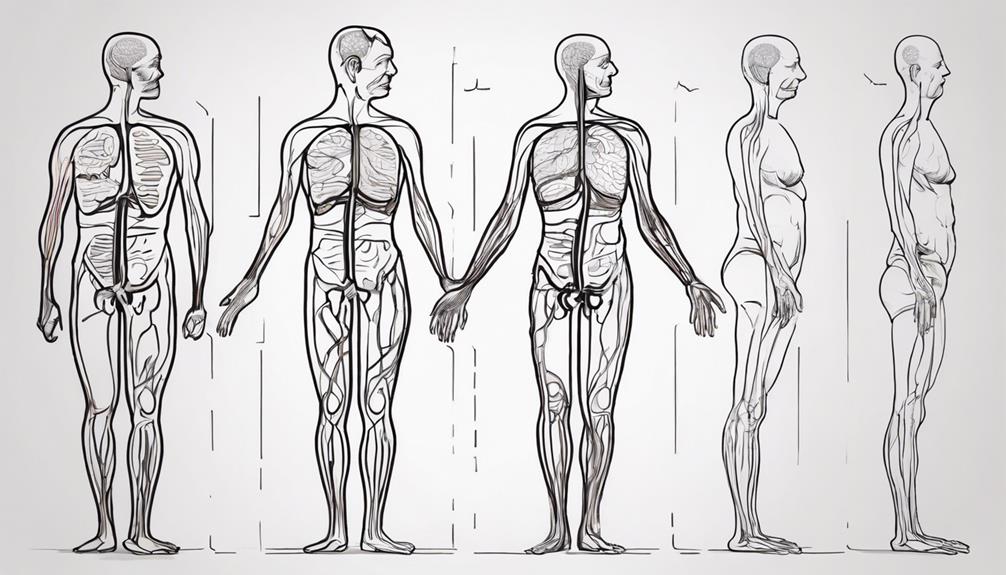
The aging process manifests significant alterations in the digestive system, characterized by weakened digestive muscles and diminished production of digestive juices. As individuals age, the muscle tissue in the digestive tract may lose strength, leading to reduced motility and potential issues with nutrient absorption. The decline in digestive juices, essential for breaking down food effectively, can further impede the absorption of nutrients. Older individuals often experience a decrease in metabolism, impacting the efficiency of nutrient absorption within the digestive system. These changes can result in a higher prevalence of constipation among aging individuals. To support digestive health in later years, incorporating a high-fiber diet, adequate hydration, and regular physical activity can help maintain optimal digestive function. Understanding the shifts in the digestive system with age is crucial for implementing appropriate dietary and lifestyle interventions to promote overall well-being in older adults.
Urinary System Changes
As individuals age, changes in the urinary system become more evident. Bladder capacity tends to decrease over time, leading to more frequent urination and potential issues with incontinence. Additionally, kidney function may decline with age, emphasizing the importance of maintaining urinary health through lifestyle choices and preventive measures.
Bladder Capacity Decreases
Resulting from reduced elasticity and muscle strength, bladder capacity undergoes a decrease as individuals age. Weakening bladder muscles can contribute to bladder incontinence in older adults. Factors such as maintaining a healthy weight and avoiding bladder irritants are crucial for preventing bladder problems. Engaging in Kegel exercises regularly can help strengthen the pelvic floor muscles, improving bladder control. Additionally, establishing and maintaining good toileting habits and avoiding constipation play a vital role in managing changes in bladder capacity. By being mindful of these aspects, older adults can take proactive steps to preserve their bladder health and overall quality of life.
Kidney Function Declines
Aging is accompanied by a decline in kidney function, primarily attributed to a reduction in the number of functional nephrons. This age-related decline in kidney function is further influenced by reduced blood flow to the kidneys and alterations in kidney structure. As individuals grow older, the kidneys become less efficient in filtering blood, leading to a decreased clearance of waste and toxins from the body. Older adults may also experience challenges in concentrating urine and regulating fluid balance. These changes put individuals at a higher risk of developing kidney diseases and can impair the overall function of the kidneys. Understanding these age-related alterations in kidney function is crucial for managing and promoting healthy aging.
Cognitive Changes
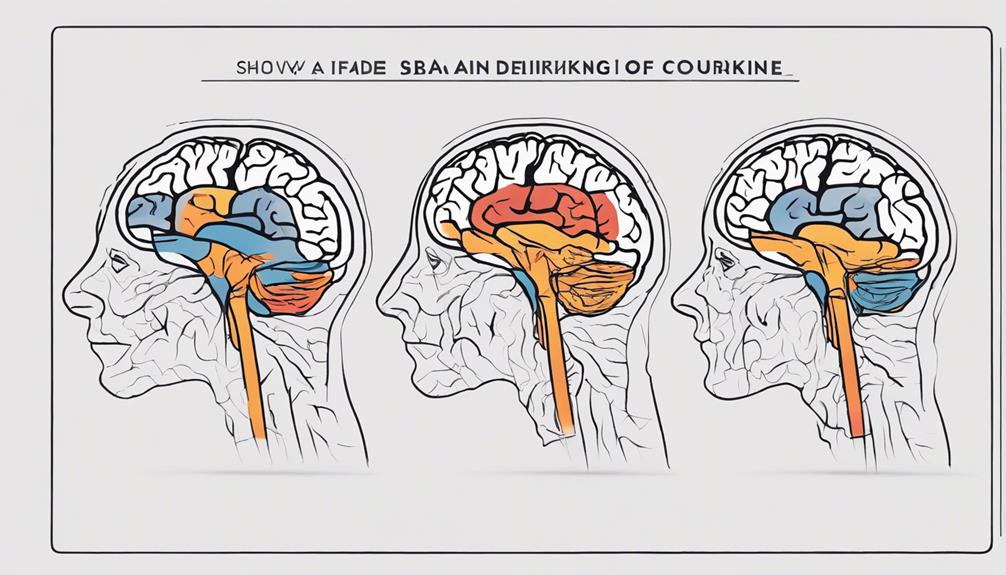
Age-related cognitive changes manifest in various ways, including declines in memory, attention, and processing speed. As individuals age, they may encounter challenges such as learning difficulties, multitasking inefficiencies, and reduced cognitive flexibility. These changes can be unsettling, but understanding the following points can provide clarity and guidance:
- Varied Experiences: Age-related cognitive changes can vary among older adults due to factors like genetics, lifestyle choices, and overall health status.
- Progressive Conditions: Some individuals may develop mild cognitive impairment, a condition that can potentially progress to more severe cognitive disorders like Alzheimer's disease.
- Strategies for Maintenance: Engaging in mentally stimulating activities, maintaining social interactions, and participating in regular exercise can aid in preserving cognitive function as individuals age.
- Personalized Approaches: Tailoring cognitive interventions to individual needs and preferences can be beneficial in addressing cognitive changes and promoting overall well-being in older adults.
Sensory Changes
Sensory changes in older adults encompass a range of physiological alterations affecting various sensory organs and systems. In the eyes, the stiffening of the lens with age can impact close-up vision, while a decrease in nerve cells can impair depth perception. Changes in hearing are common, attributed to noise exposure and aging, often resulting in difficulty hearing high-pitched sounds. The senses of taste and smell gradually diminish as individuals age, and receding gums can expose teeth to decay over time. Additionally, aging skin becomes thinner, less elastic, and more fragile, increasing susceptibility to bruising and tearing. In terms of mobility, decreased leg muscles and stiffer joints can hinder movement, contributing to an elevated risk of falls due to the body changes that occur with aging. These sensory changes highlight the intricate ways in which the human body evolves over time, underscoring the importance of adapting to these transformations to maintain overall well-being.
Dental Changes
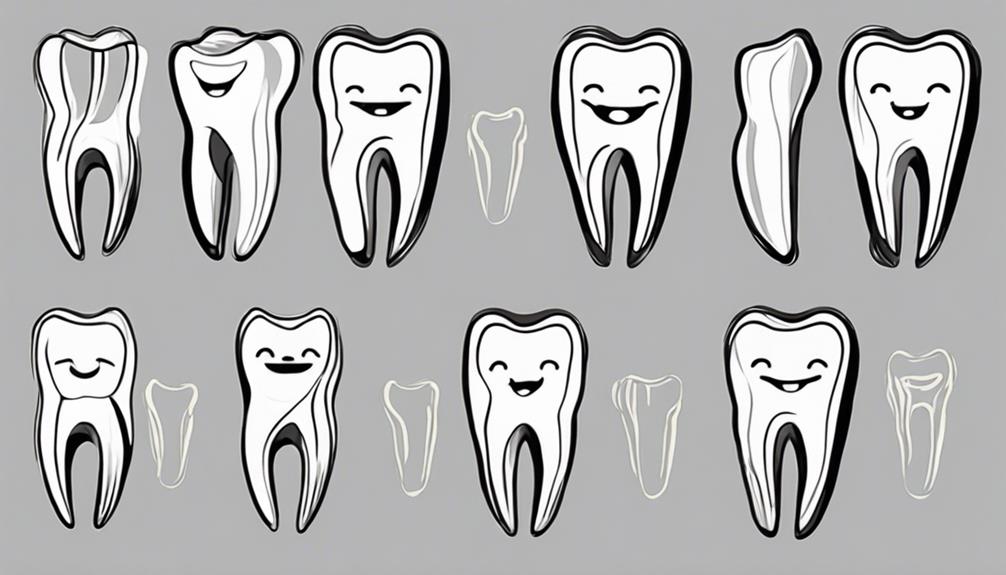
Gums may recede from teeth with age, potentially increasing susceptibility to decay, as part of the broader spectrum of physiological changes that affect oral health in older adults. Several factors contribute to dental issues in aging individuals, such as decreased saliva production and the side effects of medications. To maintain good oral health as we age, regular dental checkups are crucial for early detection and prevention of potential problems. Here are some key points to consider:
- Gum Recession: The recession of gums exposes more of the tooth surface, making them prone to decay.
- Dry Mouth: Certain medications can lead to dry mouth, reducing saliva flow and increasing the risk of dental issues.
- Importance of Dental Checkups: Regular visits to the dentist help in monitoring oral health and addressing any concerns promptly.
- Daily Oral Hygiene: Brushing teeth twice a day and flossing daily are essential habits to prevent decay and maintain oral hygiene.
Skin Changes
As individuals age, their skin undergoes significant changes such as thinning and decreased elasticity, leading to a higher susceptibility to damage. The development of wrinkles and age spots are common manifestations of these aging processes. Understanding these skin changes is essential in developing effective strategies for skin care as individuals grow older.
Wrinkles Formation
The formation of wrinkles in the skin is primarily a consequence of the diminished production of collagen and elastin as individuals age. This process is influenced by various factors such as exposure to UV rays, facial expressions, and lifestyle habits. Here are some key points to consider:
- UV rays accelerate wrinkle formation by breaking down collagen fibers.
- Facial expressions and muscle movements contribute to dynamic wrinkles.
- Skin thins with age, making wrinkles more visible.
- Factors like smoking, dehydration, and inadequate skincare can worsen the appearance of wrinkles.
Understanding these mechanisms can help individuals make informed choices to potentially slow down the development of wrinkles as they age.
Decreased Elasticity
With advancing age, the skin undergoes a progressive decline in elasticity attributed to the dwindling production of collagen and elastin. This loss of elasticity manifests as sagging, fine lines, and wrinkles, impacting the skin's ability to bounce back and maintain firmness. Factors such as sun exposure and smoking can accelerate this process by further reducing collagen and elastin levels. Skincare routines that focus on hydration and protection from harmful UV rays play a crucial role in maintaining skin elasticity. By understanding the importance of collagen and elastin in skin health and adopting appropriate skincare practices, individuals can help mitigate the effects of decreased elasticity and promote healthier, more resilient skin as they age.
Frequently Asked Questions
How Does Your Body Change as You Get Older?
As individuals age, their bodies undergo various physiological changes. Muscle mass tends to decrease, leading to reduced strength and physical performance. Bone density diminishes, increasing vulnerability to osteoporosis and fractures. Hormone levels fluctuate, impacting overall health. Skin elasticity declines, resulting in thinning and wrinkling. Metabolism rate may slow down, affecting energy levels. Cognitive decline, vision changes, hearing loss, and reduced joint flexibility are common. Understanding these changes is crucial for promoting healthy aging.
How Do Human Beings Change Develop as They Age?
As human beings age, they undergo a spectrum of physiological changes. Cognitive decline, joint pain, muscle loss, skin wrinkles, hormone changes, vision deterioration, menopausal symptoms, bone density reduction, hearing loss, and metabolism slowdown are common occurrences. These alterations can impact overall health and well-being. Understanding these developments is crucial in promoting healthy aging strategies and enhancing quality of life in older individuals.
At What Age Does Your Body Start to Decline?
The body's decline typically commences around age 30 with a gradual reduction in muscle mass. Subsequently, changes in skin elasticity, bone density, and joint flexibility may become apparent in the 40s and 50s. Metabolism rate, hormone levels, cognitive function, and vision acuity may start to diminish in the late 60s and beyond. Immune response, energy levels, and overall physiological resilience also decline progressively with age.
What Are the Three Ages Your Body Changes?
The three main ages that denote significant physical changes in the body are older age (60-75 years), old age (75-90 years), and very old age (90-100 years). These stages are characterized by various physiological alterations such as hormonal fluctuations, cognitive decline, musculoskeletal deterioration, metabolic changes, skin aging, vision decline, hearing loss, immune system weakening, and cellular aging. Each age range presents distinct challenges and adaptations as individuals progress through the aging process.
Conclusion
In conclusion, the aging process brings about various changes in our bodies, including cardiovascular, musculoskeletal, digestive, urinary, cognitive, sensory, dental, and skin changes. One interesting statistic is that by the age of 65, about 30% of adults experience some form of cognitive decline. Understanding these changes and taking proactive steps to maintain a healthy lifestyle can help mitigate the effects of aging and promote overall well-being in older individuals.
